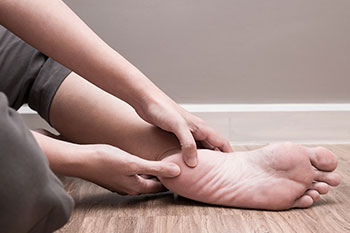
The Graft Jacket, from Wright Medical, was developed for ulcer repair and tendon repair and is used to treat fat pad atrophy.
One common complaint that we get in our office is "I feel like I am walking on my bones." During weight bearing the plantar foot is cushioned and protected by the plantar fat pad. This anatomic structure is organized as fat lobules held in place by surrounding fiberous septa.
Five individual sub-metatarsal pads combine to form the metatarsal plantar pad. The metatarsal fat pad is constrained dorsally by attachments to the capsule of the metatarsal heads and to the more plantar sub-dermal layer. These fat pads act as a shock absorber to cushion, defuse force, and resist shear during weight bearing. This fat pad also acts to protect and cushion the underlying bone, tendons and neurovascular structures of the foot. This plantar fat pad can become displaced or atrophied from any number of traumatic events including multiple surgical incisions, fractures, or chronic metatarsal plantar flexion. These conditions often result in a painful plantar weight bearing surface that can lead to callus, or worse, ulceration.
Several attempts at surgical correction over the years have been attempted with little success. Most of these lacked long-term correction and pain relief due to the migration, short resorption profile, or inconsistent delivery characteristics of the material. A couple of years ago, a novel surgical treatment was introduced using Graft Jacket from Wright Medical which was developed for ulcer repair and tendon repair. Graft Jacket is a human dermal collagen template that is readily incorporated into the body. The matrix undergoes a patented process that renders that material essentially acellular and is freeze dried with a proprietary process that prevents the formation of ice crystals to preserve the intact matrix including vascular channels. Graft Jacket Matrix contains collagen, elastin, hyualuronan, fibronectin, blood vessel channels, and proteoglycans.
A key factor to Graft Jacket is an intact, three-dimensional matrix to build on. The three-demensional structure provides a means for the body to rebuild the area of missing tissue. Another important aspect of Graft Jacket is that it is readily revascularized by the body. This means that new blood vessels gain access through preserved blood vessel channels and allows the conversion of Graft Jacket into the host tissue.
The surgical procedure involves a minimal incision near the area of interest to create a pocket for the graft in the deep subcutaneous tissue layer. Next, with a suture technique the graft is pulled into the pre-determined position. Then the subcutaneous layer is closed, the skin is repaired, and the foot is placed in a soft compressive dressing. The patient should remain non weight-bearing for 2 weeks. Using diagnostic ultrasound pre- and post-operatively, we can see the change in the thickness of the fat pad.
This minimally invasive procedure provides a new technique to treat fat pad atrophy when previous surgical attempts had been unsuccessful.
